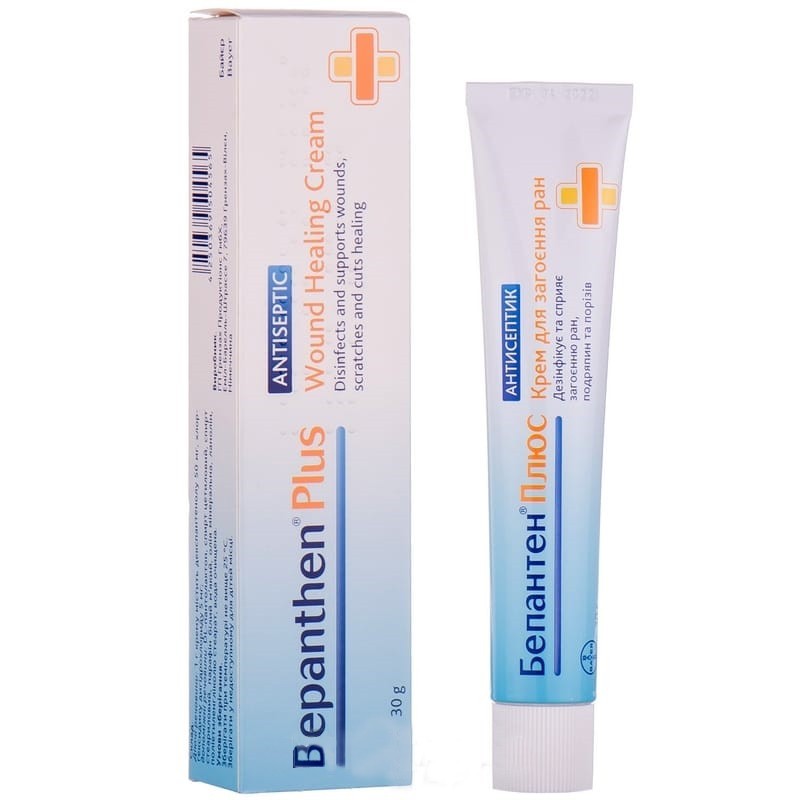



 Secure and encrypted payment processing
Secure and encrypted payment processing We ship to over 40 countries including the USA, UK, Europe, Australia and Japan
We ship to over 40 countries including the USA, UK, Europe, Australia and Japan Guaranteed refund or reship if you haven't received your order
Guaranteed refund or reship if you haven't received your orderchlorhexidine is an antiseptic that is well tolerated and has a bactericidal effect against gram-positive bacteria, especially sensitive strains of staphylococcus aureus, the microorganisms that are most often associated with skin infections.
To a lesser extent, chlorhexidine dihydrochloride is active against gram-negative pathogens. Some species of Pseudomonas and Proteus are resistant to chlorhexidine. It has low activity against fungi and is inactive against viruses.
Dexpanthenol, the active ingredient in Bepanten® Plus, in skin cells it quickly turns into pantothenic acid and acts like a vitamin. But dexpanthenol has an advantage, since it is absorbed more quickly than pantothenic acid when applied topically.
Pantothenic acid is a component of vital coenzyme A (CoA). In this form, acetyl coenzyme A (CoA) plays a leading role in the metabolism of each cell. Thus, pantothenic acid is necessary for the formation of epithelium and the healing of damage to the skin and mucous membranes.
Pharmacokinetics The absorption of chlorhexidine through intact skin was not detected. In infants who were bathed in a washing 4% chlorhexidine gluconate solution, low concentrations of chlorhexidine in the blood plasma (1 μg / ml) were observed.
Little is known about the spread of chlorhexidine in organs and tissues, since absorption through the skin is minimal. When taken orally, 300 mg in healthy adults. Cmax in plasma, a component of 0.2 μg / ml, can be determined after 30 minutes
Chlorhexidine after topical local application is not actually absorbed. After oral administration, chlorhexidine is almost completely excreted in the feces.
Dexpanthenol is rapidly absorbed by the skin. In skin cells, it quickly turns into pantothenic acid and replenishes the endogenous reserves of this vitamin.
Pantothenic acid in the blood binds to plasma proteins (mainly β-globulin and albumin). In healthy adults, the concentration is about 500-1000 μg / L and 100 μg / L in blood and serum, respectively.
Pantothenic acid does not break down in the body and is excreted unchanged. 60–70% of the oral dose is excreted in the urine, the rest with feces. In adults with urine, 2–7 mg is excreted, in children, 2–3 mg / day.
For adults and children from 1 year of age, apply the drug once or several times a day, depending on need, on previously cleansed affected areas of the skin. with repeated use, the daily dose should not exceed 5 g.
You can apply dressings if necessary.
The frequency of application of the drug and the duration of treatment are determined on the recommendation of a doctor individually, depending on the clinical signs of skin damage. Avoid use on large areas of the skin.
Hypersensitivity to dexpanthenol and / or chlorhexidine or any other components of the drug. Do not apply to perforated eardrum.
Disorders of the immune system, skin and subcutaneous tissue. allergic reactions, including allergic skin reactions, such as contact dermatitis, allergic dermatitis, itching, erythema, burning, eczema, rash, urticaria, edema, skin irritation, vesicles.hypersensitivity, anaphylactic reactions and anaphylactic shock (potentially life-threatening) with appropriate laboratory and clinical manifestations, including asthma syndrome, mild to moderate reactions that potentially affect the skin, respiratory system, gastrointestinal tract, cardiovascular system, including the cardiovascular failure.
Contact with eyes, ears and mucous membranes should be avoided. in case of contact with eyes, rinse thoroughly with water.
Bepanten® Plus, it is not recommended to use for the treatment of skin irritations the probability of infection of which is low (for example, with a sunburn). In such cases, it is recommended to use Bepanten® cream. Do not use for allergic skin diseases without infectious complications.
Large, heavily contaminated deep wounds, as well as wounds resulting from bites and punctures, require medical attention (there is a risk of tetanus). If the size of the wound remains large for 10-14 days or the wound does not heal, the advisability of prescribing should be reviewed. It is also necessary if severe perifocal hyperemia occurs, the wound swells, severe pain appears, purulent exudation intensifies or damage is accompanied by fever (risk of sepsis). The drug should not be used to treat infected wounds with profuse purulent exudation.
If symptoms persist or the condition worsens, you should consult a doctor.
Use during pregnancy and lactation. In the study of reproductive function in animals, no risk to the fetus was revealed. However, during pregnancy, the drug Bepanten should not be used.® Plus, on large surfaces of the skin, since there are no data on controlled studies in pregnant women.
The drug can be used by women during breastfeeding, but you should refrain from using it on large surfaces of the skin. If the drug is used to treat nipple cracks, it should be washed off before breastfeeding.
Children. The drug is used in children from 1 year.
The ability to influence the reaction rate when driving vehicles or working with other mechanisms. Does not affect.
Chlorhexidine is incompatible with saponifiers and other anionic compounds. bepanten® plus is not recommended to be used simultaneously with other antiseptics to prevent their mutual influence (counteraction or inactivation).
With topical use of the drug, cases of overdose are unknown.
Dexpanthenol, even in high doses, is well tolerated and considered non-toxic. Hypervitaminosis is unknown.
An increase in the level of aminotransferase after self-poisoning with chlorhexidine is described.
Often, after repeated topical application, skin irritation may occur in the same areas of the skin. The drug is intended for the treatment of superficial skin lesions. Avoid use on large areas of the skin.
At a temperature not exceeding 25 ° C.